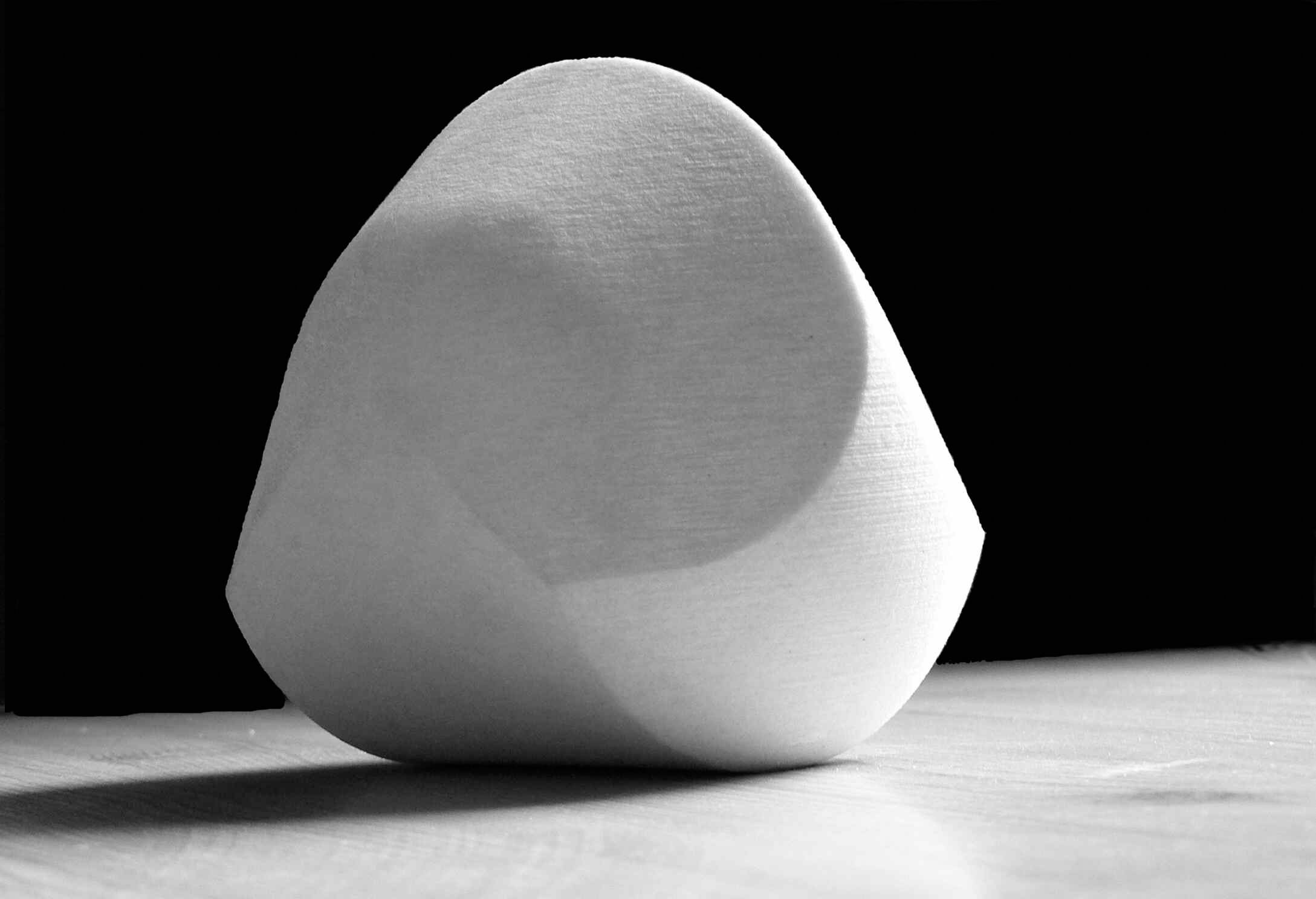This mathematician is making sense of nature’s complexity
Hungarian scholar Gábor Domokos aims to understand the physical world by describing its forms in the simplest possible geometry.

It takes Gábor Domokos about an hour to pick his way up into the hills that rise over Budapest. He stops along the way to look for lizards and rescue a beetle that had gotten stuck on its back. If he were to keep going, he’d soon reach a tower with a panoramic view of the Danube and its course through the city. But he stops where the dirt path cuts across a patch of exposed grayish-tan rock crisscrossed with cracks and strewn with stone fragments.
“Look at this—look at this mosaic!” Domokos sits down on the ground and picks at cracks in the rock, feeling for loose pieces. “This was what first captured my attention. It’s such an absolute beauty.”
To Domokos, 61, a professor at the Budapest University of Technology and Economics, this ordinary rocky outcrop is a wellspring of mathematical questions.
Inspired by rock cracks, Domokos devised a new framework for classifying polygonal tessellation that’s flexible enough to accommodate messy natural patterns, but rigorous enough to be useful. Applied in geology, it reveals universal patterns in the geometry of fractures at every scale from mud cracks to the tectonic jigsaw, and it’s now helping NASA scientists understand the surfaces of other worlds. His work on the geometry of pebbles has helped trace erosion on Earth and Mars. In the hands of MIT researchers, Domokos’s work on the balancing points of 3D forms inspired the design of a self-orienting pill capsule for delivering vaccines to the stomach. And most recently, Domokos teamed up with chemists to use his rock fracture geometry to predict how molecules assemble into “2D” sheets—a notoriously stubborn problem usually left to supercomputers.
“Gábor’s problems are somehow topological, somehow geometric, somehow mechanics, partial differential equations. Some [are] crazy,” says Sándor Bozóki, a mathematician at the Institute for Computer Science and Control in Budapest, who has published with Domokos. “He’s not a leading figure in any of these fields,” says applied mathematician Alain Goriely of Oxford University. But, he adds, like the best applied mathematicians, “he is using them in the most clever and beautiful way.”
“The first thing that people do when they understand something: give it a name,” Domokos says. “And shapes don’t have names.”
Krisztina Regős, mathematician
Best known for co-discovering the gömböc—the first convex 3D shape with just two balancing points—Domokos aims to understand the physical world by describing its forms in the simplest possible geometry.
He often begins new projects by concocting original ways to classify shapes. To prove that the gömböc existed before they found it, he and Péter Várkonyi introduced mathematically precise definitions of flatness and thinness. To categorize pebbles, Domokos counts their number of stable and unstable balancing points. And to describe tessellating patterns in rock cracks or nanomaterials, he calculates just two numbers: the average number of “tiles” meeting at each vertex in the “mosaic” and the average number of vertices per tile.
The point is to find “a new language” to describe the shapes, says mathematician Krisztina Regős, one of Domokos’s graduate students. “The first thing that people do when they understand something: give it a name,” Domokos says. “And shapes don’t have names.”
But with the right language, it’s possible to start asking questions: Do homogenous 3D shapes with just two balancing points exist? Yes. These shapes minimize flatness and thinness, and one is the gömböc—which, thanks to its geometry, always rights itself no matter how it is set down. What happens to pebbles as they erode? They lose balancing points, getting rounder and then flatter over time. What does the Earth break into when it falls apart? Plato was right: on average, it breaks into cubes.

Of course, fields like geomorphology already have schemes for classifying objects of study—there are several ways of cataloguing pebbles, for instance, says Mikaël Attal, a geomorphologist at the University of Edinburgh. But as a perpetual outsider, Domokos either doesn’t know or doesn’t care about upsetting convention. Even within mathematics, he doesn’t fit into a discipline.
The “dark secret,” says Domokos, is that he’s really an architect—his research group even sits in the same architecture department where he studied in the 1980s. As a mathematician and scientist, Domokos is largely self-taught. He credits much of what he knows to the secondhand German texts he bought at a little shop near the university during his student days. A worn first edition of the German mathematician Carl Friedrich Gauss’s Werke still stands alongside pebbles and other significant knickknacks on the shelves of his home office. By the time Domokos earned his doctorate in 1989, the year communism ended in Hungary, he’d morphed into an applied mathematician.
András Sipos, a professor in Domokos’s department, sees this unusual background as one reason for Domokos’s originality. “He is not stuck to the symbols and the language of one field,” he says.
By describing shapes to understand the forces that sculpt them, Domokos and his colleagues are asking what Marjorie Senechal, a mathematician and historian of science at Smith College, calls “growth and form” questions—a reference to D’Arcy Thompson’s 1917 book On Growth and Form, a foundational text of mathematical biology.
“They’ve taken up the question again of the relation between growth and form, or local development, local patterns, and global patterns,” says Senechal, who is an honorary member of Domokos’s department. The tension between local and global, tile and mosaic, appears in “all great problems,” she adds, “whether it’s biology, or whether it’s physics, or whether it’s philosophy.”
Domokos is more apt to describe the problems he works on as simple, not great. Indeed, it’s easy to underestimate the significance of his work while talking with him. Though his vivid, rambling anecdotes often include run-ins with Fields medalists or Nobel laureates, they never come across as haughty. And he’s quick to play down his own accomplishments. He was the youngest person to join the Hungarian Academy of Sciences when he was elected in 2004 at the age of 43, and he was a visiting fellow at Cambridge’s Trinity College. But he’s reluctant to say he’s been successful. “If you take out the gömböc,” he says, “then I am not visible as a scientist.”
Talk to others, and the picture is clearer. In geomorphology, Domokos’s work on pebbles and fractures “is a major contribution,” says Attal, whose own research focuses on the evolution of hillslopes and rivers. Senechal notes that he “may be humble,” but he “is using very contemporary mathematics” to describe nature. Bozóki calls him “too modest” and says he’s well respected in Hungarian academic circles. When Bozóki travels to foreign conferences and says he’s Hungarian, he adds, he’s often asked whether he knows Domokos.
Still, there is truth to the idea that Domokos chases simple problems. In mathematics, “it’s very easy to ask very hard questions,” says Bozóki. One of Domokos’s gifts seems to be an intuitive sense of which questions don’t just look simple, but really are.
When his curiosity leads him to some exciting new problem, says Sipos, Domokos usually devises some “toy” version first and works up from there, testing the border between the known and the unknown.
“He told me that doing science means that you are addressing the question along this border,” says Sipos, who is also Domokos’s former graduate student. “And this is difficult to find.”
This pattern is playing out now in Domokos’s work on tessellations. The relatively simple model he developed for rock cracks became a predictive tool for nanotechnology once infused with a few additional layers of mathematical complexity. Now, he and his colleagues are trying to leap from describing form to modeling growth: in recent papers, they introduced crack healing and formation to their geometric framework describing tessellations.
Science should be about proof, says Domokos, but “questions are guiding science. And the questions are certainly not a matter of proof. They are a matter of intuition.” And along the hazy borders of the known and unknown, mathematics and science, Domokos has a good eye for cracks—places like his spot in the Buda Hills where, with just a little tug, stone falls away.
Based in Austria, Elise Cutts is a freelance science writer covering physics and geoscience.
Deep Dive
Culture
The tech that helps these herders navigate drought, war, and extremists
Shiny, high-tech solutions often miss the mark. Can a simpler data-distribution project be the answer?
Why Threads is suddenly popular in Taiwan
During Taiwan’s presidential election, Meta’s social network emerged as a surprise hit.
Threads is giving Taiwanese users a safe space to talk about politics
But Meta's discomfort with political content could end up pushing them away.
What tech learned from Daedalus
Even 35 centuries ago, people imagined using technology to overcome physical limits.
Stay connected
Get the latest updates from
MIT Technology Review
Discover special offers, top stories, upcoming events, and more.